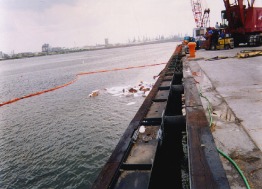A little over a month ago, more than 10,000 barrels of crude oil wound its way through the quiet residential streets of Mayflower, Arkansas transforming a private cul de sac and surrounding wetlands into an estuary for ExxonMobil Oil. While cleanup and rebuilding still remain priorities in the town, the far-reaching effects of the spill are still rippling through the conversations of environmentalists, economists, and policy-makers throughout the US.
When the Pegasus Pipeline burst on the unsuspecting community in late March 2013, the Environmental Protection Agency immediately labeled it a major spill. Responders evacuated 22 homes in total, and Exxon offered full compensation for local households affected. Crews worked around the clock during the first few weeks following the spill, recovering a reported 4,500 barrels of oil and water, testing soil and water samples, and scrubbing the tar sands oil from the streets.
“Living in an area where people have been affected by natural disaster myself, it’s sad to know that other people have to be evacuated because of man-made disasters that might have been prevented,” junior Isabelle Berton said. Berton’s home was only doors down from the wrecked Sandhills seawall in Scituate during the Nor’easter Nemo.
White House correspondent Jay Carney said that with government involvement in a situation like this one, “steps are taken to mitigate the damage and hopefully avoid them in the future.” Although immediate responders looked positively into the future of the spill’s clean-up, environmental groups had more concerns about the impact that oil spills like the one in Arkansas will have on the long-term.
Many environmental legislation issues are already becoming top priority in political debates and discussions. Several of those issues rose to the federal government’s attention as the Obama administration continued to work towards passing the New Keystone XL Pipeline Project. The New Keystone Project proposes to open pipelines between a pipe network in Nebraska and the Canadian border, where oil companies could transport tar sands and crude oil.
Most residents of Mayflower, Arkansas had no knowledge before the spill that a major oil pipeline ran underground near their homes. Most of the underground pipelines for Pegasus are around 70 years old, which is consistent with, if not slightly older than, most of the pipelines in use in the US today. Activists, including those with the NRDC (National Resources Defense Council), argue that the federal government should neither allow big oil companies to build new pipelines, nor pump crude oil in these older pipes, especially when so few people are aware that it is happening.
The NRDC and other activist groups feel that their local environments have suffered enough at the hands of large oil companies. SHS’s own environmental club recognizes this most recent oil spill in a chain of biochemical incidents as a clear indicator of the growing need for renewable energy. “The Scituate community has attempted to turn its own energy needs to renewable resources with the windmill and their proposed efforts at powering municipal buildings through a solar panel field. At the high school we have been increasing our recycling output to decrease our carbon footprint,” said Mr. Brogna, the advisor for the environmental club.
The entire community around the tar-sands spill has suffered. Mayflower citizens fear that their property values plummeted due to the oil spill and the close proximity of the pipeline to their town. Resale values of homes are expected to decrease in any area where the pipelines are laid or granted for use. Due to heavy emissions during tar sands and crude oil extractions, most environmental groups term crude oils as highly polluting substances. As more spills in Missouri, Minnesota, Texas, and across Canada catch the attention of the media and activist groups, the debate on legislation for oil pipelining extends further into 2013.
